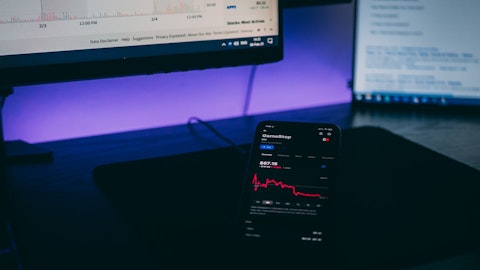Joseph Mastrangelo: Just one other thing on that question, is we start flowing parts from suppliers in a controlled fashion, so that lets you get quality control over your material flow. We have a workforce here that you start to train on the operations and get them up to speed. And more importantly, when you want to scale and run an operation 24/7, you put your leadership team in place, you let them start running under a controlled fashion. We’re all learning and we’re ramping into that. But the important thing here is, as you look at the schedule for this project in ERCOT, we’ve tailored the production and shipment of those to their schedule and also to allow us to manage our capital efficiently.
Christopher Souther: Okay, thanks. And then just the remaining CapEx amount and timing on Line 1. I think you previously talked about $40 million to $50 million of CapEx for that. But Slide 9 is it’s like $30 million. Is that just coming in under previous cost assumptions? Or was that prior $40 to $50 million, including some of that additional subassembly automation? And then just where are we in the CapEx for Line 1?
Nathan Kroeker: So I’ll just — I think you’re on it. I’ll just clarify a couple of things. We have previously said $40 million to $50 million to build a fully automated line. That fully automated line has a nameplate capacity of two gigawatt hours or higher. So you’re absolutely correct in those numbers. What… Was the first automated line, we’re assuming that it has an output of 1.25 gigawatt hours. We’re also assuming that we don’t have full automation of the subassemblies on day one. And so as we look at the CapEx associated with get to 1.25 gigawatt hours of production, that’s around $30 million. So less than what it will be on subsequent lines. And part of that is we don’t have the same amount of cost associated with the sub-automated subassemblies.
So it’s lower cost, but also lower output. At a later date, we could go in and add some of that automation and get the capacity of that line up above two gigawatt hours as well, but we can do that as a separate stage in the process.
Christopher Souther: Okay. And where are we in that $30 million spend?
Nathan Kroeker: The second part of your question is of that $30 million, where are we at? First of all, it’s two primary nation design and systems that ACRO is working on. And the second large bucket of cost in there is all of the tooling that’s associated with the new parts and the new line. We are approximately 40% of the way through paying for the line.
Christopher Souther: Okay. Perfect. And then maybe just a last one here. On the current pipeline, can you give us a sense of the mix overall from a percentage of gigawatt hours between utilities, smaller customers, ICP like just what does the overall mix look like? It seems like it’s shifting more towards kind of the blue-chip utility type customers, but I wanted to get a sense where are we in that shift, just given the size of some of those potential customers?
Nathan Kroeker: Yes. No, we talked a lot today about some of these blue chip names in the portfolio, the utilities versus the independent we want a diversified portfolio of projects, both in terms of utility backed versus independent developer. We also want a portfolio in terms of large projects and small projects run of the meter behind the meter. I would say we’re very comfortable with the portfolio of projects that we have, and we’re going to continue to manage it as a portfolio.
Operator: And for your next question, it comes from the line of Joseph Osha from Guggenheim.
Joseph Osha: A couple of questions. First, as we think about meeting these LPO conditions precedent, I know there’s a lot that’s complicated, but can you characterize for me what you think the real challenges are and what we should be focused on as you move through that process?
Nathan Kroeker: Listen, Joe, I don’t think there’s anything there that we can’t accomplish. They take different amounts of effort and different amounts of time, but we’re moving forward on all fronts. Some of them have to do with real estate, some have to do with capital requirements to get to first advance. Some of them are things like permitting. And so nothing there that we’re seeing as an insurmountable challenge. We’re just working through the process.
Joseph Mastrangelo: And Joe, I think the big gating item is the first line.
Joseph Osha: Okay. I’m just trying to understand as investors, how we should think about this other than sort of one day the press release drops. Is there some way you have that you might be able to communicate with us in progress towards meeting those CPs?
Nathan Kroeker: The number1 thing, like Joe said, is the first line. And so we’ll continue to give updates on where we are at with the first line. I think that’s the most critical thing to be watching.
Joseph Osha: Okay. And then next question, between now and then your shipping product that’s still more expensive product off of the semi-automated line. Is it the case that by the time you factor in what it costs you to make that product? But then you’ve got the $45 sort of counterbalancing it. Does that — by the time you put that all in the mix, is this a positive gross margin proposition or not?
Nathan Kroeker: Sorry, were you asking about a specific point in time? What was the first part of your question?
Joseph Osha: Well, between now and when the automated line comes up I’m trying to understand whether this revenue — we expect this revenue that you’re generating between now and then, which is de minimis, but it’s there, right? But in particular, by the time you add the 45x credits back, is there more money coming in the door and been going out? That’s my question.



